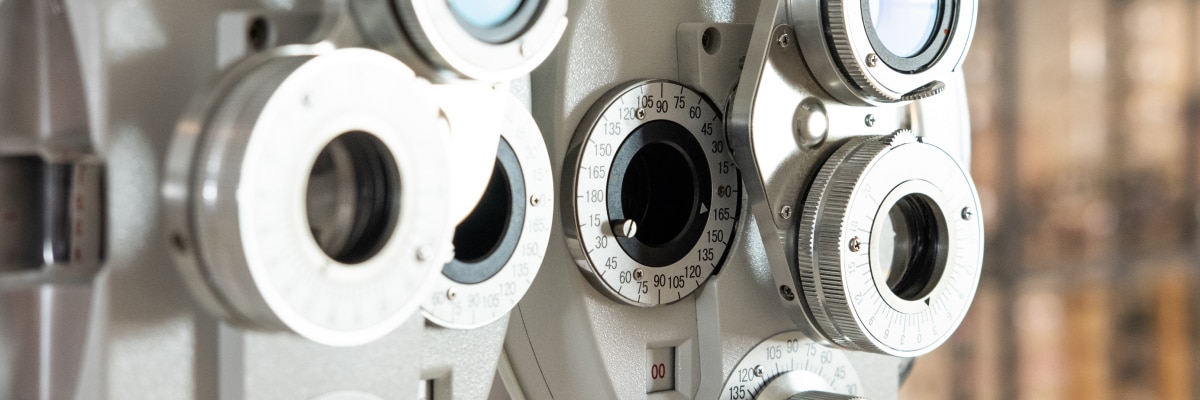In the EBD Blog
Reviewed by Sonia Kelley, OD, MS on September 22, 2023
A refraction eye exam is a series of tests done by an eye doctor to determine whether a patient needs corrective lenses. If they do, the tests measure the patient’s vision prescription so their glasses provide the best possible correction.
A refraction exam allows an eye doctor to see if and how a person’s vision prescription has changed over time. Major prescription changes can notify your eye doctor of an underlying problem within one or both of your eyes. This is one of many reasons why regular eye exams are important for clear vision and healthy eyes.
If you experience any sudden or extreme vision changes, contact your eye doctor immediately. Don’t wait for your next scheduled appointment.
What Is Eye Refraction?
Refraction is how light bends as it travels through different mediums. So, refraction in the eye describes how the eye bends light as it moves through its different structures, particularly the cornea and the lens.
The cornea and the lens are structures at the front of the eye. They are responsible for bending light so that it focuses perfectly on the retina at the back of the eye. When everything works as it should, clear eyesight is achieved.
But sometimes, there are certain problems called refractive errors that can interfere with this process. Refractive errors can result from irregularities in the cornea, the lens, or the eyeball itself.
Types of Refractive Errors
Depending on the type of refractive error present, a person can have blurry distance vision, blurry near vision, or both. The most common types of refractive errors include:
Myopia
Also called nearsightedness, most types of myopia occur when the eyeball is longer than average. So, while the cornea and lens are doing their job to focus light properly, the light falls in front of the retina instead of directly on it. Sometimes, myopia is caused by the cornea having too steep a curvature. Both of these result in blurry distance vision while up-close objects appear clear.
Hyperopia
On the opposite end of the spectrum is hyperopia or farsightedness. Hyperopia describes an eyeball that is shorter than average or a cornea that is curved too little, which causes light to focus past the retina. This makes close-up vision appear blurry while distance vision is clear.
Astigmatism
Astigmatism is a refractive error that usually results from irregularities in the cornea, but it can also occur due to imperfections in the lens. The cornea is the clear, frontmost surface of the eye. If you look at the profile (side view) of the eye, the cornea should be evenly curved, like a ping pong ball.
In corneal astigmatism, the cornea looks more like the back of a spoon — the curvature is uneven. Lenticular astigmatism has this same concept, except it applies to the shape of the lens rather than the cornea.
If there is irregular curvature in the cornea or lens, light coming into the eye is distorted. This causes the light to scatter instead of focus, which makes vision blurry at all distances (near and far).
Presbyopia
Presbyopia is an age-related vision change that affects a person’s ability to see and read up close. Throughout your life, the natural lens of the eye changes shape to bring different objects into focus at different distances. But around age 40, the lens begins to lose its flexibility and it isn’t able to focus as well as it used to. This causes blurred vision when performing near tasks like reading.
What to Expect During a Refraction Test
During a refraction exam, your eye doctor and their staff will perform a few tests to measure how your eyes bend incoming light. The tests they do to assess this include autorefraction, manual phoropter refraction, and, in some cases, retinoscopy.
Autorefraction
This test is a quick and easy way to get a general idea of a person’s refractive error and its severity. It is often performed by a staff member at the beginning of the appointment using a machine called an autorefractor. To use it, the patient must sit in front of the autorefractor and rest their chin on a designated part of the machine.
One eye at a time, the patient looks through the measuring window and focuses on a picture that moves in and out of focus. While this is happening, the machine takes several readings of how the eye responds to the image. The autorefractor then averages the readings to present a prescription for each eye.
Manual Refraction
When you think of an eye exam, the phoropter is probably the first image that pops into your head. It’s a large, mask-like machine with lots of dials and lenses attached to it. In the exam room, your eye doctor will position the phoropter in front of your face and have you look through it to focus on an image or chart across the room.
You’ll be asked to compare a series of images or letters by looking at them through different lenses. Then you’ll tell the optometrist which option is clearer. This is known as subjective testing because you’re voicing your preference.
The phoropter helps your doctor determine what type of refractive error you have, if any. It also helps them establish your vision prescription and how curved the lens must be to best correct your vision.
Retinoscopy
Eye doctors may also include a retinoscopy in the exam if their patient is a child or has trouble communicating. This test uses a handheld tool, called a retinoscope, to shine light into each of the patient’s eyes. The doctor will move the light around while looking through the pupil and observing how light reflects off the back of the eye.
Retinoscopy informs the eye doctor of a refractive error without relying on patient input like when using a phoropter. Thus, retinoscopy is part of objective testing.
The retinoscope also allows the doctor to examine the health of the patient’s ocular surface, detect early cataract development, and evaluate how your eyes focus on a nearby object (also called accommodation).
Refraction Eye Exam Cost and Coverage
The cost of a refraction eye test varies depending on which eye care provider you see. While refraction is usually part of a comprehensive eye exam and is included in the cost, some practitioners offer it as an a la carte option.
Pricing also depends on whether you have vision insurance and what your coverage includes. It’s best to call your preferred eye care practice and ask for cost information before booking your appointment.
Does Medicare or Medicaid Cover Eye Refraction Exams?
Original Medicare does not cover refraction exams. However, certain Medicare plans, such as Medicare Part C, provide coverage for vision, dental, and hearing.
While Medicaid coverage varies from state to state, some mandatory benefits are required by the federal government. Vision care for children under 21 years old is one of those mandatory benefits, and it should cover a refraction test for those who qualify.
For specific coverage details, it’s best to research Medicare and Medicaid coverage in your home state.
How Often Should You Have an Eye Refraction Test?
The frequency at which someone should have refraction testing depends on their age and risk for developing eye disease. Here are some basic guidelines to consider regarding eye exam frequency:
- Healthy adults under age 60 – Get a comprehensive eye exam every two years.
- Adults who wear prescription glasses and/or contacts – Get a comprehensive eye exam every one to two years.
- Adults over age 60 and people with a family history of refractive errors – Get a comprehensive eye exam every year.
It’s best to follow your eye doctor’s recommendations to maintain clear and healthy vision. If they recommend more frequent eye exams based on your eye health, you should follow their advice.


